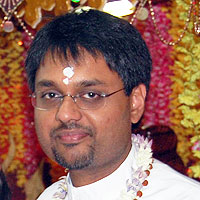From a satsang with Pt. Dr. Umesh Persad, Spiritual Leader, SWAHA Gyaan Deepak Kirtan Mandali
While the first five energies of the Das Mahaa Vidyaa represent the prime principles of existence, the last five represent the methods of attaining yogic transformation. The underlying meanings of these divine manifestations offer spiritual practices that can lead to self-realisation.
Chinnamasta is a fierce depiction of the Devi, who holds her severed head in her hands with blood spouting from her neck. In Sanaatan Dharma, the concept of cutting off the head usually refers to the stopping of the mind and perception, which leads to the dissolution of the ego. Liberation is defined as stopping the mind’s constant churning. Chinnamasta Devi, therefore, severs all the knots and blockages on the path of self-realisation.
In terms of the yogic practice, it is said that we should question what makes us aware of an object. Then, we should concentrate on the light that makes the object perceivable. That shift in perception is known as Chinnamasta. It requires that we participate in self-enquiry and keep the mind quiet in order to detect the subtle light of awareness. Meditation’s aim is to quiet the mind and remain in that stillness and awareness that is the true self.
Dhoomavati Devi represents the void. She also represents the blessing of suffering. We all suffer from time to time, as our desires are unfulfilled; we suffer from physical and environmental illnesses, mental suffering and death. Dhoomavati also means ‘smoke’. The nature of smoke is that it conceals and obscures, but at the same time, it also reveals. She is the power of concealing and revealing. When we suffer, we turn towards spirituality. No one questions the nature of the self or reality when they are happy. It is pain that makes us question our existence. Dhoomavati is the power that transforms one from being deluded by the world to thinking and questioning, ‘Who am I?’ She represents voidness, stillness or non-being in everything. She is the calmness of the ocean when there are no waves. She is inaction in action; she is the principle of doing our duty in this world but recognising the stillness that exists within the activity.
Bhagalamukhi is the power of immobility, restraint and holding back. In terms of the yogic practice, it means bringing stillness to the body, mind and speech. Every yogic practice requires stillness of the body. She also represents retention of the breath. Yoga silences the fluctuations of the mind. Thoughts appear in the mind and then dissolve. The spiritual practice involves observing the thoughts as they appear and then observing the silence between the thoughts, as the mind is just a series of thoughts. Find time every day to be by yourself and be still.
Matangi Devi represents the power of creative expression. She is the equivalent of Saraswati Devi. She represents vaikhari or the expressed word. There are creative people who feel the urge to create. One should express oneself in the creative flow of Matangi. The musician and other artistes should practise daily, as an expression of the self and to gain access to the divine creative flow.
Kamala Devi is the equivalent of Lakshmi Devi and represents delight, harmony and beauty. She sits on a lotus flower, which represents unfoldment. We must begin to unfold our divine nature by seeing the harmony and beauty of everything outside us as well as inside us. We must become beautiful in character. Kamala Devi removes spiritual poverty; she represents spiritual wealth: control of the senses, of the mind, withdrawal from the world, endurance, single-pointedness of mind, faith, contentment and all the qualities of real wealth.
If, as devotees, we can select at least one of these spiritual practices that appeal to us, that path will lead to stillness of mind and the experience of the Divine.



